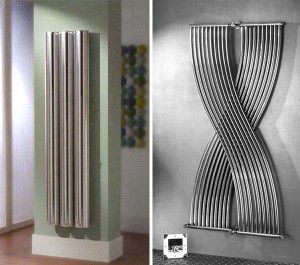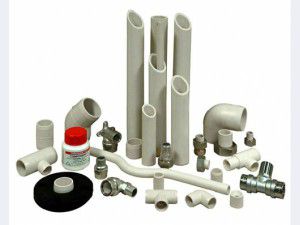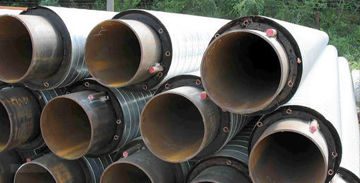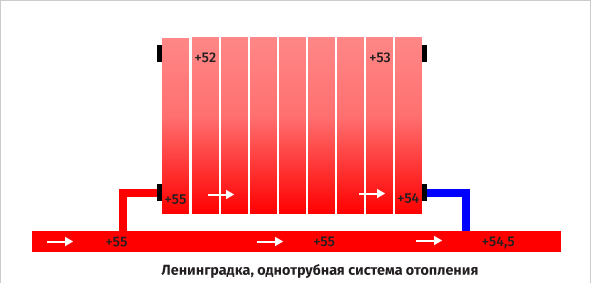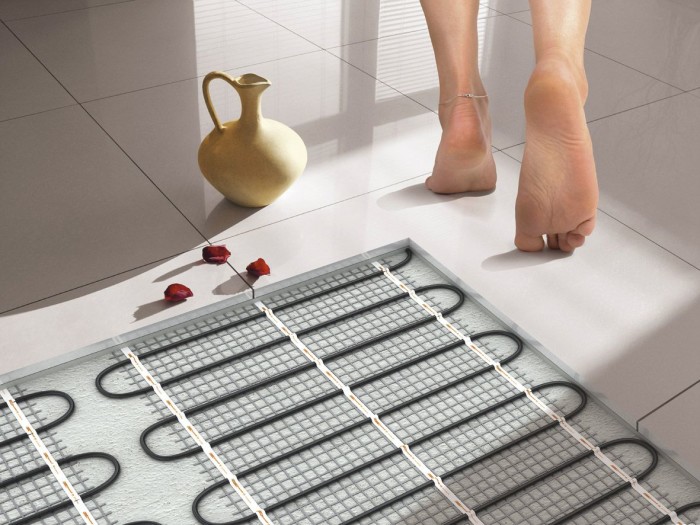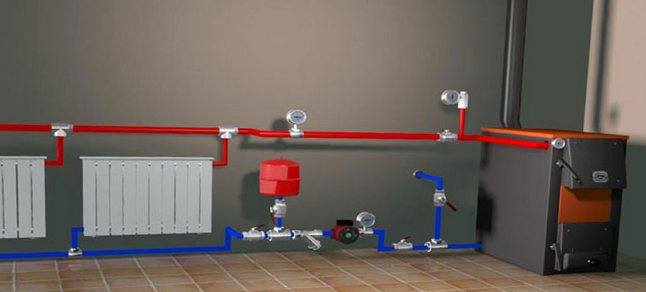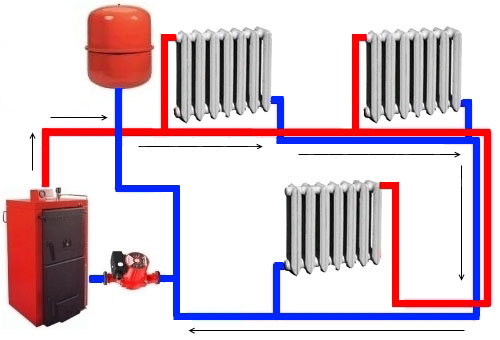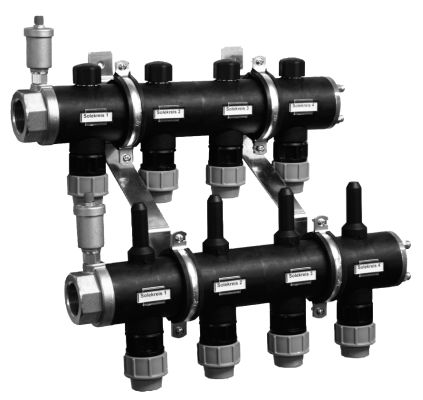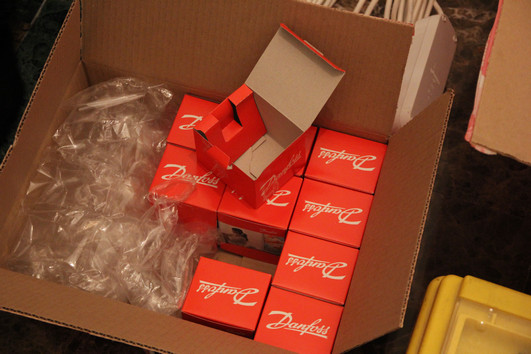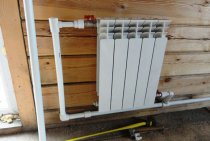Existing heating systems
Many heat supply systems of Russian cities are designed for maximum heat load, and as a mode of heat supply they use a heating schedule straightened at the "break point" at a temperature of direct network water T1\u003d 70 "C for closed and at temperature T1=60 "C for an open heating system. During operation at air temperatures close to those calculated for heating, the temperature graph is "cut off" (Fig. 1). For example, 150 "C with a "cut" at 130 "C (or 130" C with a "cut" at 120 "C). At the same time, a significant number of heating systems of buildings are connected according to a dependent scheme through elevators. In these systems, as a rule, there is a misalignment of the thermal regime in the “rectification zone” of the heating schedule with overheating of subscribers and a misalignment of the thermal regime in the “cutoff zone” of the heating schedule with underheated subscribers, which is caused by the joint transport of thermal energy for heating and hot water supply.
Misregulation of the thermal regime in the “cutoff zone” is largely due to the underestimated heating surface of the heating heater, which is calculated for the temperature of direct network water without taking into account the “cutoff” of the heat supply schedule during operation. Another reason for the misalignment of the thermal regime is the irregularity of the DHW temperature schedule during the heating period, which is associated with the general schedule for the supply of thermal energy. To exclude this, when designing heat supply systems, it is advisable to use a more realistic temperature regime of heat networks, based on minimizing the consumption of network water for hot water supply.
In some cities, so-called combined heat supply systems are operated, in which part of the DHW load is connected according to an independent scheme (closed system), and part - according to a dependent scheme (open system). From an energy point of view, such systems are initially inefficient, since for subscribers with an independent DHW connection scheme, it is necessary to straighten the direct network water temperature line at the “break point” T1\u003d 70 "C, i.e. 10 "C higher than for subscribers with a dependent DHW scheme. As a result, subscribers with dependent connection of the DHW system experience overheating. Based on this, the reconstruction of open systems by a partial transition from a dependent DHW connection scheme to an independent scheme is also inefficient and is not considered further.
In recent years, in some heat supply systems, a gradual transition has been made to an independent heating scheme with the installation of automatic regulators and channelless laying of heat networks in PPU insulation, the reliability of which decreases with an increase in the temperature of direct network water, and its use at a temperature of 130 ° C and more is generally prohibited. At the same time, the transition to an independent heating scheme and a decrease in the temperature of direct network water lead to an increase in network water consumption (up to 20%) and a corresponding increase in the diameters of the heating network. In this connection, the optimal direction for the reconstruction of heat networks is the simultaneous transition to a temperature regime of 130/70 "C (120/70" C) and to increased schedules for the release of thermal energy with straightening at the "break point" for a closed system at a temperature of T1\u003d 80-85 "C and at temperature T1\u003d 70-75 "C for an open heating system (Fig. 2). At present, increased heat supply schedules are widely used in the closed heat networks of OAO Moscow Heating Network Company, connected to thermal power plants of OAO Mosenergo.
How to reduce heating costs
- Installing a solid fuel or electric boiler - savings, depending on the current state of affairs, can reach 50%.
If I live in an apartment building
- if an AJOAH is established in the house, decisions are made by the general meeting in accordance with the charter of the AJOAH;
- if there is no AJOAH in the house, decisions are made with the consent of all co-owners of the apartment building.
At home level
- Installation of common building meters for heat and electric energy - 15% savings.
- Arrangement of an individual heat point (weather regulator) with a thermoregulation system - 40% savings.
- Switching to electric heating at home - the effect depends on additional factors.
- Modernization of the heating system - 25% savings.
At the apartment level
It is important to understand here that we are talking about very conditional figures. It is possible, for example, that the installation of apartment meters will lead to an increase in payment if energy efficiency measures are not carried out for the whole house.
- Installation of an apartment heat energy meter - saving up to 15%.
- Installation of an apartment gas consumption meter - saving up to 40%.
- Installation of modern heating radiators - 10% savings.
- Installation of thermostats for modern heating radiators - saving 10-25%.
Reconstruction of the heating system legal advice
By virtue of par. "c" clause 35 of the Rules for the provision of housing and communal services to owners and customers of premises in multi-apartment buildings and residential buildings, approved by Decree of the Government of the Russian Federation of 05/06/2011 No. 354, the buyer is not entitled to arbitrarily dismantle or turn off the heating parts provided for by the design and (or) documentation in technical terms for an apartment building or housing stock, to arbitrarily increase the heating surfaces of heating systems installed in a residential building, more than the indicators provided for by the design and (or) documentation in technical terms for an apartment building or housing stock.
According to Part 1 of Art. 25 of the Housing Code of the Russian Federation, the reconstruction of a residential building is the installation, replacement or transfer of engineering networks, sanitary, electrical or other equipment, requiring amendments to the technical passport of the residential premises.
Reconstruction and (or) redevelopment of the premises for living is carried out in compliance with the requirements of the law in agreement with the local government (hereinafter referred to as the body that carries out the approval) on the basis of the decisions made (part 1 of article 26 of the LC RF).
Unauthorized are the reconstruction and (or) redevelopment work of the premises for living, carried out in the absence of a decision of the authorized authority on approval or in violation of the reconstruction and (or) redevelopment project.
The owner of a living space that has been arbitrarily rearranged and (or) replanned, or the employer of such a living space, in accordance with a social tenancy agreement, is obliged to restore such a living space to its previous state within a reasonable time and in the manner established by the body that carries out the coordination. 3 article 29 of the LC RF).
Therefore, in the resulting situation, only two scenarios are possible: either the heating system in your apartment must be brought to the first state, or the reconstruction must be agreed upon in the manner prescribed by law.
At the same time, it does not matter when the instructions will be issued to the rest of the citizens who have carried out such a reconstruction. There is no connection between these events.
It is worth paying your attention that if the system is brought to the first state by the management company, then the price of these works can rightfully be billed to you for payment, since their implementation at the expense of funds prepared for the maintenance of common property will be inappropriate. Of course, the same prescriptions of the Criminal Code are very often ignored, referring to the lack of authority.
But you must always remember about Part 5 of Art. 29 of the Housing Code of the Russian Federation, which provides that if a suitable housing unit is not restored to its previous state within a specified period of time, the court, at the claim of the body that carries out the coordination under the conditions that another court does not decide to keep the premises in a re-planned and (or) re-arranged state, makes a decision :
Of course, the same provisions of the Criminal Code are very often ignored, referring to the lack of authority. But you must always remember about Part 5 of Art. 29 of the Housing Code of the Russian Federation, which provides that if a suitable housing unit is not restored to its previous state within a specified period of time, the court, at the claim of the body that carries out the coordination under the conditions that another court does not decide to keep the premises in a re-planned and (or) re-arranged state, makes a decision :
1) in relation to the owner of the sale at public auction of such premises for living with payment to the owner of the proceeds from the sale of such premises for living, minus the costs of executing a court decision imposing on the new owner of such premises for living the obligation to restore it to its previous state;
2) in relation to the tenant of such premises for living in accordance with the social tenancy agreement on the termination of this contract with the imposition on the owner of such premises for living, who was the landlord under the specified agreement, the obligation to bring such premises to their previous state.
Radiators and heating pipes
In addition to modern heating boilers, pipes and radiators are no less important components. They are necessary for the efficient transfer of heat energy to the air in the room. During the design of the system, it is necessary to solve two problems - to reduce heat losses during the transportation of the coolant through pipes and to improve the heat transfer of the batteries.
Any modern heating radiators must not only have good heat transfer performance, but also a design that is convenient for repair and maintenance. The same applies to pipelines. Their installation should not cause difficulties. Ideally, the installation can be carried out by the owner of the house himself without the use of expensive equipment.
Modern heating radiators
Design of heating radiators
To increase heat transfer, aluminum is increasingly being used as the main material for manufacturing batteries. It has good thermal conductivity, and casting or welding technology can be used to obtain the desired shape.
But keep in mind that aluminum is very sensitive to water. Modern cast-iron heating radiators do not have this disadvantage, although they have a lower energy intensity. To solve this problem, a new battery design has been developed, in which the water channels are made of steel or copper pipes.
These modern heating pipes practically do not corrode, having minimal dimensions and wall thickness. The latter is necessary for efficient thermal transfer of energy from hot water to aluminum. Modern heating radiators have several advantages, which are as follows:
- Long service life - up to 40 years. However, it depends on the working conditions and timely cleaning of the system;
- Choice of connection method – top, bottom or side;
- The package may include a Mayevsky crane and a thermostat.
In most cases, models of modern cast-iron heating radiators are made designer. They have classic forms, some of them are made in the floor version with artistic forging elements.
The efficiency of a heating radiator depends on the correct installation and connection method. This must be taken into account when installing the system.
Modern heating pipes
Polymer pipes for heating
The choice of modern heating pipes largely depends on the material of their manufacture. Currently, polymer lines made of polypropylene or cross-linked polyethylene are most often used. They have an additional reinforcing layer of aluminum foil or fiberglass.
However, they have one significant drawback - a relatively low temperature exposure threshold up to +90°C. This entails a large thermal expansion and, as a result, damage to the pipeline. Products from other materials can serve as an alternative to polymer pipes:
- Copper. From the point of view of functionality, copper pipelines meet all the requirements for a heating system. They are easy to install, practically do not change shape even at extremely high coolant temperatures. Even when water freezes, the walls of copper lines will expand without damage. The disadvantage is the high cost;
- Stainless steel. It does not rust, its inner surface has a minimum roughness coefficient. The disadvantages include cost and labor-intensive installation.
How to choose the optimal configuration of modern heating? To do this, it is necessary to use an integrated approach - to make the correct calculation of the system and, according to the data obtained, select the boiler, pipes and radiators with the appropriate performance characteristics.
The video shows an example of modern home heating using a warm floor system:
WHAT THE REPAIR OF THE HEAT NETWORK CONSISTS OF
Restoration work is being carried out in stages:
- search for existing damage using special equipment
- dismantling of channel ceilings
- analysis of a faulty section of the pipeline
- canal cleaning works
- laying a new section of the heating network and insulating the pipeline
- installation of new shut-off and control valves when changing the design of the structure
- crimping
- laying floor slabs
- waterproofing processes
Upon completion of the repair of the heating main, the pits are covered with sand and soil, which is subsequently compacted. A layer of gravel is laid on the resulting surface and a concrete base is poured for subsequent asphalting. The repair of heating networks in Moscow is completed by landscaping. All work is carried out by qualified employees with significant experience in these processes.
Two-pipe heating system
There are two options for connecting radiators to the heating system:
The only plus of a single-pipe system is savings on pipes. But the minus is significant - the radiator closest to the boiler is the hottest, and the farthest is the coldest. And it’s also problematic to turn off some kind of radiator - they are all in the same circuit. If this is not critical, why not use this option? It's a perfectly normal pattern.
The two-pipe scheme is more flexible:
- All radiators are almost equal. Water is supplied to each at the same temperature;
- You can set your own temperature on each radiator by regulating the flow of water through it;
- You can painlessly shut off the water supply to any radiator, for example, when it's hot or you need to flush the radiator;
- More convenient for increasing the number of radiators.
For the sake of justice, it must be said that in the two-pipe version, the last radiator is somewhat “offended”, it gets less heat. The reason is that on it the pressure difference between supply and return is almost zero and the water flow is minimal.
So what choice did I make?
That's all for today. In the following articles I will bring to your attention a gas heating system, underfloor heating, infrared heating. Comment, ask questions. Thanks, see you!
A country house is the dream of every city dweller. This type of real estate has a lot of advantages over an apartment, ranging from the absence of noisy neighbors to the picturesque surrounding landscapes. But one of the fundamental advantages of living outside the city is still the ability to choose and implement the most productive and inexpensive heating system.
The most common and popular heating scheme for a private cottage today is water heating with a lower wiring. Of course, since its inception a hundred years ago, it has undergone significant changes and modernization, acquired several modifications, and therefore there is plenty to choose from. Moreover, of all the existing schemes, it is the water scheme that is distinguished by the most optimal combination of “price-efficiency” parameters.
Underfloor heating system
Underfloor heating technology is a convenient and economical space heating system. Modern installations use progressive materials. For the manufacture of pipelines, light and durable polymeric materials are used.
The basis of a warm electric floor is a heating cable. The main thing in this type of heating is the quality of the cable, on which the efficiency of the system and the duration of its service depend. Warm floors using water do not emit harmful substances, electromagnetic radiation. Water is a cheap and heat-intensive heat carrier. A network of pipelines is installed, through which the liquid flows, between the base and the floor covering. Compared to the electrical system "warm floor", this type of heating is much cheaper.
The energy supply policy pursued in recent years involves the transition to renewable energy sources. Increasingly, for the production of electricity, not gas and coal are used, but the sun, wind, water energy. These are environmentally friendly energy sources that do not pollute the environment with emissions and discharges.
We save heat. For this, it is useful to know that
A heat meter in an apartment connected to centralized heating allows you to track how much heat you received and pay only for that amount. The thermostatic valve on the radiator will allow you to control the temperature in the house, apartment or a separate room. The power and heat dissipation of the heater must correspond to the size of the heated room and it should be turned off if no one is at home. Heaters and radiators are more efficient if they are not covered by furniture, heavy curtains, clothing, or decorative panels. Sometimes a decrease in heat transfer occurs due to the lining of radiators, and therefore heat cannot freely spread throughout the room. If the lining is easy to remove, check how the heat transfer will be without it. Batteries with a smooth dark surface enhance heat dissipation. Therefore, clean the radiator from a layer of old paint and apply a new layer of a darker shade. Choose biometallic radiators. We are accustomed to cast iron batteries, which are installed in almost all houses with central heating. But they have a low heat transfer, unlike aluminum radiators. However, there is another option: biometallic radiators. They are distinguished not only by high heat transfer, but also will last much longer. The underfloor heating system is a way to bring heat exactly where it is needed most. For example, under the desktop or on the floor area where residents walk. Before the start of each heating season, check the system
It is necessary to eliminate air pockets, repair the places of possible leakage, paying special attention to the joints of the system parts. This will avoid breakthroughs during operation of the system in the cold season.
A geyser or boiler that has worked for 15-20 years should be replaced, as over time these devices lose their effectiveness. Blackout curtains help keep the heat in the house, but interfere with the flow of heat from the radiators. Thick carpet reduces heat loss through the floor. Modernization of the ventilation system, namely heat recovery, is a real way to save money.
Water heating at home
In this case, the coolant is water or special liquids, for example, non-freezing.Here, the heat sources are also very different depending on the fuel. But if there is warm air in the air system comes
into the room, then into the water air of the room heated by appliances
who give him heat stored in water
.
And the water stores a lot of heat. There is such a thing: "heat capacity", remember? If in your own words
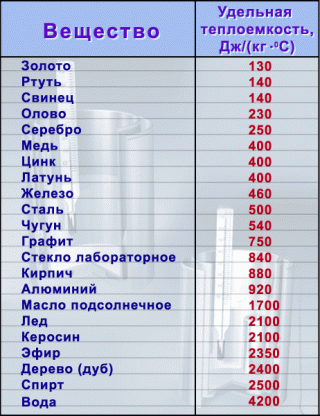
It turns out that we get a chic coolant almost for nothing.
Yes, the water system is somewhat more complicated, but it is also more flexible.
Imagine that heated water can be supplied through pipes anywhere and there it will give off the accumulated heat.
And the pipes can be easily hidden in the walls, or you can not hide them at all, modern ones look very aesthetically pleasing.
How does water give off heat? For this, several types of devices have been created:
Radiators - massive, for example cast iron, sections assembled into batteries.
Hot water flows inside them. They give off thermal energy mainly due to infrared radiation (radiation).
They are usually steel or aluminum, less often copper. The surrounding air, being heated by the convector, begins its natural upward movement. That is, a flow (convection) of air is created, which removes heat from the convector.
Modern aluminum appliances also belong to convectors, although they are called radiators. It should be noted that now almost all thermal water heating devices are called radiators, although strictly speaking, this is wrong. But let's not be smart.
Air is pumped through them to be heated. They are often used in supply ventilation systems to heat cold air entering from outside.
"Warm walls" - were used in the seventies in panel housing construction. A serpentine from a steel pipe was embedded in the concrete panels, into which water was supplied from the heating system. I remember from childhood the warm walls of panel five-story buildings.
Let's take a closer look at the options for heating systems for low-rise buildings.
The main types of water heating wiring
To date, there are several main options for piping around the house when using water heating:
Single pipe. The so-called "Leningrad", in which one pipe connects all the heaters in the house in the direction of the coolant. Such a scheme is chosen for simplicity, minimal financial (the price of highways is generally lower) and labor costs.
But at the same time, the heating of the radiators is uneven, and it is impossible to regulate the temperature in each of the batteries;
-
Two-pipe
. The connection of heating radiators is made by two pipes laid parallel to the movement of water in the system.
The advantages include the ability to quickly adjust the temperature, quick and uniform heating of the premises, accessibility; -
Collector arrangement of pipes
. It has its own supply and return pipeline, connected together with the help of special distribution manifolds.
Feature - beautiful appearance, full control over all the batteries in the house from the distribution cabinet.
The main advantages of water heating of the cottage
As you can see in the photo and video of country houses on our website, water heating schemes are used quite often in our country.
There are many reasons for this widespread use:
- The ability to perform installation work on the arrangement of home heating at any stage of construction. In addition, even in a finished house, water heating is installed without any problems;
- Water itself has excellent qualities when used as a heat transfer medium. High thermal conductivity, availability and low cost, along with unique heat capacity, make water the best choice;
- Versatility, the ability to use different types of fuel to heat the coolant in the heating circuit;
- Large selection of piping options in water heating schemes.You can choose a certain type depending on the mass of parameters, ranging from the area of \u200b\u200bthe cottage to financial capabilities;
- A variety of equipment for arranging home heating;
- Accurate and quick adjustment of the air temperature in each of the rooms of a private house. It is provided by the installation of special equipment, namely temperature controllers and shut-off valves.
Conclusion
Today, there is simply no more affordable or effective alternative to water heating of a private house. It should be noted that every year more and more new heat generators, pipelines and radiators appear, due to which the efficiency of the scheme increases, while its cost decreases almost several times compared to other options.
The owner of a suburban residential building with an area of more than 500 sq.m applied with a problem of operating the heating system. The difficulty of the owner was the inability to control the temperature in the premises, which led to discomfort for all family members.
The situation in which the owner found himself can be compared to the operation of an expensive luxury car, in which there is a stove, but there is no temperature regulator, not to mention climate control.
The only adjustment method found was a screwdriver, with which the valve connected from below to the radiator was covered. And, of course, such a manual way of increasing and decreasing power, the desired temperature in the room still never managed to be reached.
Danfoss engineers, having studied the wishes of the owner, proposed an automatic temperature control solution using RET2000B wireless room thermostats and recommended a certified installation company for site visit and subsequent installation.
According to the results of the site survey, it turned out that during the installation of the heating system of the house, no zonal control of radiators and convectors in the floor was provided. At the same time, a collector system was used for piping. In total, there are 5 cabinets with distribution manifolds for the radiator heating system in the house.
Installation of thermostatic elements on radiators was not possible due to the fact that they were hidden by screens, and their installation would lead to an incorrect operation mode. And given that the house had undergone a high-quality renovation using expensive materials, the only possible solution was the installation of wireless room thermostats in all rooms where it was necessary to regulate the temperature. The only additional work that needed to be done was to supply power to each cabinet to connect the switching device and signal receivers from the room thermostats.
Installation of equipment for automating the heating system took no more than 5 hours and took place in the following sequence:
- Determine the heating circuit and the heater connected to it;
- Install electric actuators on the valves of the distribution manifold of the corresponding circuits, which open or close the valve on a signal.
- Install the terminal panel in the manifold cabinet and connect the signal receivers and electric drives.
- Connect room thermostats and receivers;
- Mount the thermostat on the wall of the room at a height of 1.5 meters from the floor and set the desired temperature.
Since there was no project for internal engineering systems, the specialists were forced to empirically track all the lines from the manifold cabinet to the heater. It turned out that in the largest room, not all 12 radiators were connected to one distribution manifold. But here, too, a solution was quickly found. One room thermostat was connected to two wireless signal receivers located in different cabinets, but at the same time regulating the temperature of appliances in the same room.
The principle of operation of room thermostats is very simple: as soon as the temperature set on the thermostat is reached in the room, for example 21 ° C, the thermostat accordingly sends a signal to the receiver installed in the cabinet.And the receiver, in turn, gives a command to the electric drives connected to it to close the valve. Thus, the supply of coolant to the corresponding heating circuits is stopped, and the heat output of the radiators does not increase until the room thermostat detects a decrease in the temperature in the room.
Danfoss engineers and partners often have to deal with cases where the automation of the heating system has not been thought through during the installation of the heating system. The reason may be both the desire to save on the heating system, and the lack of the necessary qualifications from the engineers of the installation organization.
The undoubted advantage of Danfoss wireless solutions is the ability to upgrade almost any radiator heating system and water floor heating system.
